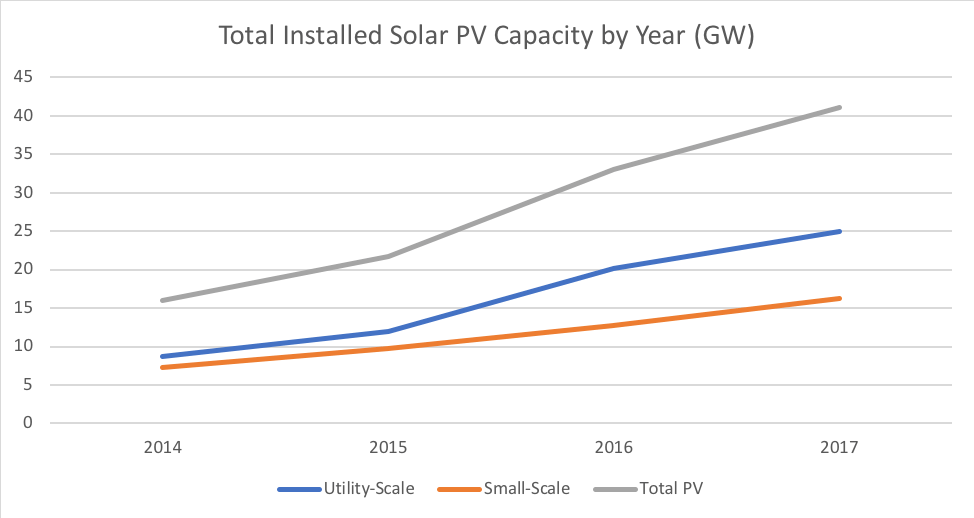Solar energy is currently the fastest growing source of electricity in the United States, and federal energy forecasters predict that this trend will continue for the next 30 years, thanks in large part to a supportive policy environment. The successful growth in U.S. solar generation since the early 2000s is evidence that strongly supportive and coordinated government policies can help greenhouse-gas reduction technologies overcome commercialization challenges.
The U.S. Energy Information Administration (EIA) reports that utility- and small-scale solar photovoltaic (PV) installations have nearly doubled since 2015, and they now represent nearly 2 percent of the electricity generated for the whole nation, with a capacity of more than 41 GW. Under current policies, the EIA projects that more than 425 GW will be deployed by 2050, generating 14 percent of total U.S. electricity.
Solar Policy
Practically speaking, solar energy has been around for decades, but adoption rates have soared dramatically in the past eight years. Exponential growth in solar energy is primarily due to federal and state policies, including, investment tax credits (ITCs), renewable portfolio standards (RPS), and the U.S. Department of Energy’s (DOE) SunShot program.
ITCs were established in the Energy Policy Act of 2005, allowing residential, commercial, and utility solar installers to deduct 30 percent of the cost of their system from their federal taxes. This has sparked solar growth by providing an incentive for homeowners, businesses, and utilities to invest in PV panels and other equipment. Legislation passed in 2016 steps down the ITC until 2022, where it will remain permanently at 10 percent for commercial and utility systems. Additionally, the industry faces headwinds from recently imposed federal tariffs on imported solar panels, which are expected to increase panel costs in the short-term. Though, panel costs represent an increasingly smaller fraction of the total cost of solar installation.
Solar energy has been around for decades, but adoption rates have soared dramatically in the past eight years. Exponential growth in solar energy is primarily due to federal and state policies, including, investment tax credits (ITCs), renewable portfolio standards (RPS), and the U.S. Department of Energy’s (DOE) SunShot program.

Solar adoption has also benefited from the growth of RPSs requiring utilities to obtain a certain percentage of their electricity from renewable sources. Over the past 20 years, twenty-nine states and the District of Columbia have implemented and/or strengthened RPSs.
In 2011, DOE launched its SunShot Initiative to collaborate with private companies, local governments, and nonprofits to study how to reduce prices and increase the market for solar generation. With a goal to reduce the cost of solar energy by 75 percent over 20 years, SunShot’s first aim was to reduce the cost of residential solar energy to 10 cents per kWh and utility solar energy to 6 cents per kWh by 2020. The utility cost goal was achieved in 2017, three years early. The next step for SunShot is to reduce residential and utility costs to 5 cents per kWh and 3 cents per kW/h, respectively, by 2030. The initiative is also working to improve PV efficiency. One SunShot program, the Foundational Program to Advance Cell Efficiency (F-PACE), has created a prototype solar cell that significantly boosts the efficiency of light-to-energy conversion.
Who is leading in solar energy?
By a wide margin, California has installed the most solar PV – 20,163 MW. Data from the Solar Energy Industry Association (SEIA) shows that other states in the top 10 have installed between 1,200 and 4,300 MW of solar PV.
| Top 10 States for Solar Energy capacity | |
| 1. California | 21,073 MW |
| 2. North Carolina | 4,308 MW |
| 3. Arizona | 3,399 MW |
| 4. Nevada | 2,595 MW |
| 5. New Jersey | 2,290 MW |
| 6. Massachusetts | 2.011 MW |
| 7. Texas | 1,874 MW |
| 8. Utah | 1,599 MW |
| 9. Georgia | 1,566 MW |
| 10. New York | 1,253 MW |
Solar Energy Industry Association (2018)
Beyond RPSs, states are taking additional actions to support solar energy. The North Carolina Energy Technology Center reports that Arizona, California, Colorado, Florida, Hawaii, Maine, Massachusetts, New Hampshire, New York, and Nevada, were the most active states in 2016 concerning solar policy. Legislation in those states included subsidies and net metering, which allows solar users to earn credit by selling excess electricity they generate to utilities.
Businesses are also helping to bolster solar growth. According to SEIA’s annual Solar Means Business Report, the top 25 corporate solar users in the United States have installed nearly 1,100 MW of capacity as of October 2016, enough to offset 1.1 million tons of carbon dioxide emissions each year. The top five corporate solar users include Target (147.5 MW), Walmart (145 MW), and Apple (93.9 MW).
Falling solar prices have attracted interest from all market segments. According to the Department of Energy, solar energy system costs have dropped by more than 60 percent since 2010, thanks to innovation in production and installation efficiency. EnergySage, a company supported by the DOE, reports that a 6 kW solar system now costs between $11,380 and $14,990 after tax credits, depending on variables like home architecture, state fees, and quality of equipment.
Declining prices as manufacturing and designs improve over time – strengthened by state and federal policies – are making solar energy more easily accessible for utilities, businesses and homeowners across the United States. In spite of an ITC phasedown and short-term headwinds from federal tariffs, solar deployments are expected to increase because, overall, prices are still expected to decline. This is welcome news. We need as many zero-emission sources as possible to achieve our climate goals and to avoid the worst effects of climate change. Relying increasingly on solar energy is a key component of an effective pathway to achieving that low-carbon future, and the policies that fueled this success should be a model for continuing further down that road.
